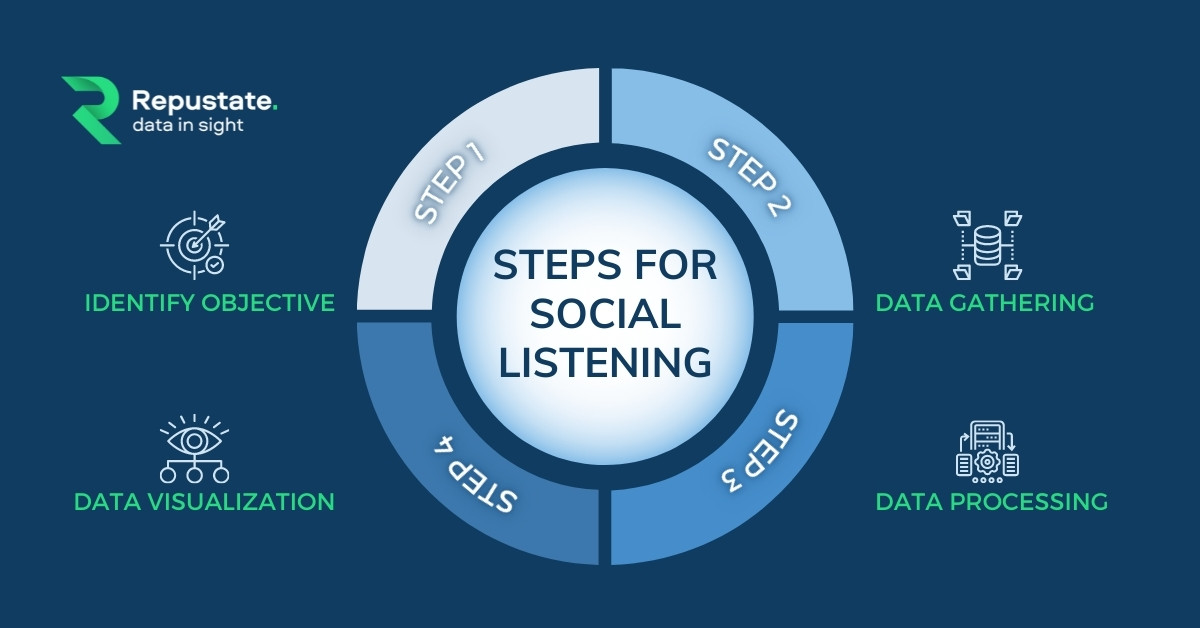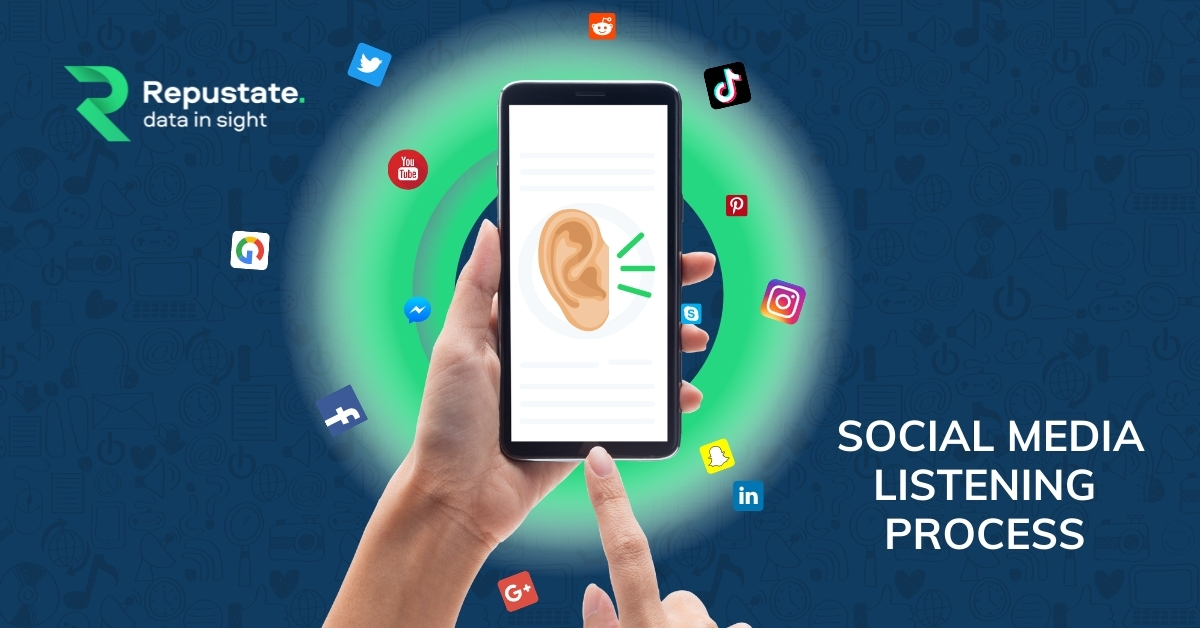Social listening Process: Understand Your Customers Step By Step
Social listening empowers you to keep a close hold on your online reputation management (ORM). The social listening process allows you to be deeply involved in what your clients, customers, and prospects think about you and your brand including your product, customer service, and content. It allows you to listen and analyze their social data and act accordingly to ensure that you are in line with your marketing and branding strategy. In this article, we aim to give you a closer look at the process of social media listening and how a really good social listening tool can help you with growing your business.
The Social Listening Process
The social listening process encompasses the following steps.

Step1: Identify Your Platforms
The first step in the process of social media listening is identifying the social media platforms that you want to target for social listening, and the social listening tools you will choose. This will depend on your objectives and KPIs.
If your audience is tech/gaming geeks, you might want to choose platforms like Twitch or Mixer. If you want to target business networking sites, you may want to focus on Facebook, Linkedin or Xing (if your audience is German or Swiss).
Similarly, Instagram Live, TikTok, YouTube, DouYu, or Youku, all will give you the data you need depending on where your audience is located.
Step 2: Data Extraction With Live API Integration
The social listening solution, with its Live API integration capability, will allow you to extract all publicly available data, including external pages that you have liked or engaged with, as Facebook and Twitch do. They allow you to download information about the user profile to a very granular level.
In this part of the social listening process, you read all the data through text analysis API and categorize entities through semantic classification - all in a matter of seconds allowing you to notice oft-occurring words with their contexts.
Furthermore, since Live API integration gives you real-time alerts, it offers two major benefits:
Avert PR issues - Be alerted any time you get a negative mention, or there is a sudden increase in your mentions. As soon as you get notifications, you can also analyze all mentions and scour trending information to get to the root of the issue. This allows you to nip the issue before it escalates thus allowing you to protect your online reputation.
Discover new trends - Having the ability to have real-time data as well as latent data, gives you the power to discover trending stories and articles. This is very important to be relevant and also for you to decide whether you want to be part of certain trends or maintain your own niche. Whether it’s Twitter threads or Flitter, be ahead of all that’s happening around you.
Apart from pulling all user profile information, the process of social media listening includes the tool sieving through thousands of comments and videos for relevant data through its named entity recognition (NER) and video content analysis (VCA) capabilities. And because it is made specifically for the social listening process, the solution identifies hashtags, emojis, special characters, social media lingo, and abbreviations.
Step 3: Data Processing for Sentiment
Once the solution mines the information from all the sources you have identified, it will process the entire data for sentiment analysis. It will process what your audience likes and doesn’t and will assign prior polarity to keywords. Prior polarity determines the positive and negative context of the word.
Sentiment intensity: The solution’s emotion mining task does not just determine the polarity, but also calculates the intensity of the polarity. For example excellent (+1), great (+0.8) good (+0.5), average 0), lacking(-0.25), poor (-0.5), disgusting (-1), etc. Thus giving you concrete knowledge of how to develop your social media voice.
Logo identification through VCA: The social listening process also identifies all the logos that can be seen in the background. This includes logos on clothing, mugs, posters, etc appearing in a video, and thus contextualizes the content of the video with the logos. This is very useful when analyzing videos for competitor brands or influencers.
Sentiment analysis for social media data is vital in the process of social media listening because you can:
-
Identify if community standards are being followed in your channel.
-
Prevent cyberbullying.
-
Avert persons using your brand for negative advertisement or affiliations.
-
See what demographic shares your content and in what context.
-
Pursue potential brand ambassadors who are relevant to your business.
-
Evaluate influencers to see if they are genuine and not marred with fake followers.
-
Engage with customers in real-time in order to build an authentic relationship with your audience.
-
Analyze your content and change it wherever necessary to make it more relevant and current.
Step 4. Data Visualization
In this step of the social listening process, the social listening tool studies all relevantly extracted information, employing data aggregation, and presents it on the front-end via its sentiment analysis dashboard. This data visualization is absolutely necessary for seeing insights in the form of comparative charts. These visualizations help in ROI analysis, telling you where and why your budget must be allocated. It also tells you which areas need effort optimization and extra attention.
Data Segregation & Alerts: It is this customer dashboard where you can even have platform-based data segregation and set alerts for sentiment on any social channel that you want to keep a close eye on, like Xbiao, FaceBook, or Twitter. This way, you can see the change in trending data in real-time throughout the process of social media listening and can monitor and take action as soon as something of relevance to your brand happens.
This information is vital for decisions like product diversification, new store locations, service improvements, or demographic changes. This could also mean better employee relationships, human resource insights, content/conference promotion opportunities through social listening on channels like Jobmeet, LinkedIn, Bark, or Xing. The possibilities are endless.
Social Listening vs Social Tracking
Although social listening and social tracking sound the same, there is an important difference between them. Social media tracking is part of the social listening process. It encompasses the tasks of identifying the sources of your mentions and then responding to your brand mentions by replying to direct messages or comments on the different social channels you own.
Social listening is much more than this. It is more holistic in nature and includes monitoring the social media profiles and channels you own and analyzing the information. The process of social listening includes understanding customer feedback, keeping a close eye on the direct mentions of your brand, and studying the conversation threads that include certain keywords, names of competitors, or topics that you have identified as relevant to you.
Unlike social tracking, where you are merely responding, the process of social media listening is what gives you the keys to social listening benefits. For it is through social listening that you actually understand the data and come to conclusions that you can use to improve your brand strategy and social media presence.
Learn about: Managing ethical challenges in AI
Boost your ORM with Repustate
Unlike Repustate’s social media listening AI engine, most listening tools in the market simply gloss over special characters and emojis because their Text Analytics API cannot decipher non text-based sentence constructs. And if they do, they analyze only limited (5 to 8) languages, unlike Repustate that understands 23 languages natively. This gives Repustate’s social media sentiment analysis tool a higher degree of authority in recognizing unique lexicons, phonology, morphology, and syntaxes in the social listening process.
Since other tools do not have native language reading abilities, they give inaccurate results despite having emoji-reading abilities. This is because if they use translations for languages, they miss out on tonality and sarcasm. This results in false positives and hence wrong overall sentiment data. Repustate’s social listening solution also deciphers industry-specific jargon, slang, and hashtags so that no matter what industry you are in, you are aware of what people are saying about you and you can take appropriate steps to harness that information to your advantage.
 Home
Home
 Aug 31, 2021
Aug 31, 2021

 Jeremy Wemple
Jeremy Wemple
 Dr. Ayman Abdelazem
Dr. Ayman Abdelazem
 Dr. Salah Alnajem, PhD
Dr. Salah Alnajem, PhD
 David Allen
David Allen

 Repustate Team
Repustate Team

